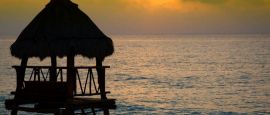Getting around Jamaica
AirLink Express (www.intlairlink.net) runs domestic flights within Jamaica.
Jamaica’s road network covers the whole island and consists of some 21,000km of roads. Hiring a car or scooter is a good way of seeing the island but extra care should be taken, especially after dark, as many of the islands roads are in a poor state of repair.
Some important considerations before setting out are: vehicles drive on the left, the country has a poor road safety record, and pedestrians, animals and erratic drivers can all prove hazards, petrol stations accept cash only, and child safety equipment is not usually provided.
Car hire firms can be found in major towns, hotels and airports and most offer unlimited mileage. A general consumption tax of 16.5% is applied to all car hire transactions, and it’s recommended to seek a rental with inclusive insurance and breakdown coverage. Drivers must be aged 25 or over, have a valid driving licence from another country and a valid credit card. The Jamaica Tourist Board offers one of the most comprehensive road maps of the island.
Rates are per car, not per passenger, with taxis hailed on the street or booked by phone. Technically, most are supposed to have meters, but it's worth agreeing on a price for the trip ahead of departure. Fares should be displayed inside the taxi but add 25% if it's after midnight. Taxis with red plates marked PPV (Public Passenger Vehicle) charge fixed rates with a 10 to 12% tip usually added. Most hotels and resorts have assigned Jamaica Tourist Board (JTB) drivers who carry photo ID and display a prominent blue JTB sticker on the front windscreen.
Although reliable services connect Kingston and Montego Bay, the rest of the island's bus schedule is patchy. The Jamaica Union of Travellers Association (JUTA) (tel: +1 876 972 4534; www.jutatourskingstonjm.com) is the largest operator of scheduled and unscheduled bus/minibus and vehicle charter services aimed at tourists.
Speed limits are 50kph (31mph) in built-up areas and 80kph (50mph) outside the main towns. Seat belts must be worn at all times and children under three years must sit in a child seat.
The Jamaica Automobile Association (+1 888 CALLJAA; www.calljaa.com) offers roadside assistance.
Drivers can use a full UK driving licence for up to 12 months or a North American licence for up to three months.
Kingston operates an erratic bus service. Most transport in the capital and other major towns is by private ‘route taxi’, usually shared minibuses that can be flagged down as they pass. They can get exceptionally crowded, but fares charged are somewhere between local bus and private cab rates.
Do you have any Feedback about this page?
© 2025 Columbus Travel Media Ltd. All rights reserved. No part of this site may be reproduced without our written permission, click here for information on Columbus Content Solutions.




 You know where
You know where
